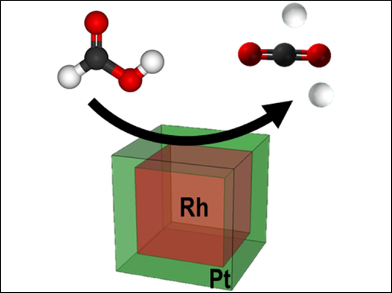Bimetallic nanocatalysts often have better performance than their monometallic counterparts. These enhancements come from the ability to control electron transfer between metals and from surface strain effects. While bimetallic systems have been studied, there remains a need to establish a link between electronic structure and bimetallic architecture with controlled faceting.
Sara E. Skrabalak, Indiana University, Bloomington, USA, and colleagues have demonstrated that catalytic performance in a shape-controlled bimetallic system can be tuned by changing the shell thickness in a core@shell architecture. This finding was achieved using a model Rh@Pt nanocube system (pictured). The team studied nanocrystals with various platinum shell thicknesses as catalysts for formic acid electrooxidation.
By selecting shape-controlled nanoparticles, changes in crystal faceting could be decoupled from electronic changes for the design of efficient nanocatalysts. According to the researchers, the strategy should also work for other bimetallic nanomaterials composed of more cost-effective metals.
- Designing Efficient Catalysts through Bimetallic Architecture: Rh@Pt Nanocubes as a Case Study,
Ethan W. Harak, Kallum M. Koczkur, Dale W. Harak, Paul Patton, Sara E. Skrabalak,
ChemNanoMat 2017.
DOI: 10.1002/cnma.201700167




